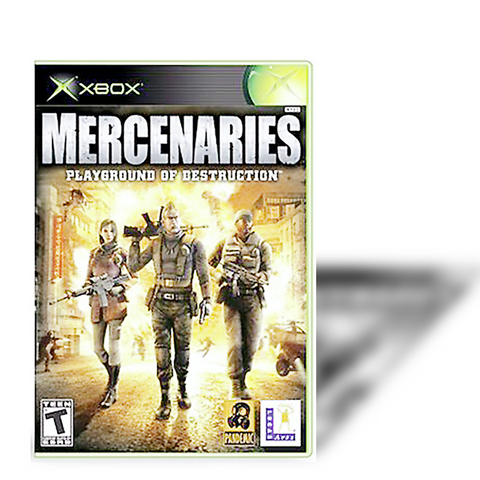Released globally last week, EA Games' long-awaited Oddworld: Stranger's Wrath is a must-buy for any gamer on the lookout for a fresh, fun and futuristic shooter experience.
The game seamlessly merges all the fun of a first-person shooter with that of a third-person adventure game, boasts a brilliant storyline and features eye-popping graphics.

The action takes place in an imaginary spaghetti-western-like world shared by peace-loving chicken-like people and gruff bulldog-like ornery outlaws.

Players take on the roll of Stranger, a bounty hunter of unknown origins and quite ungainly appearance, as he sets out to rid the town of bands of desperados who have been terrorizing the chicken people and stealing everything that's not nailed down.
Stranger collects the bounty for each outlaw he captures, be it dead or alive, and with his loot is able to purchase items such a binoculars, extra ammo pouches and so on from the general store. Unlike shooters that allow players to acquire bigger and better weaponry as they progress, Stranger totes the same critter-firing crossbow from beginning to end.

The crossbow is just one of the game's many unique features: Instead of firing bullets, Stranger loads his firepower with a wide array of bugs and creatures. Lightening bugs, talking squirrels and spiders, to name but a few of the ammo-creatures, all have their own special characteristics and allow Stranger to snare, slay or trick his enemies depending on the situation.

Players will spend much of their time running, shooting, kicking or punching, but the absorbing storyline, which is played out through cut screens, is never far away. It takes a few levels before players learn that Stranger is not simply a bounty hunter, but it is worth the wait; the more players learn about Stranger and his hidden agenda, the more addictive the game becomes.
Anyone familiar with the Marvel comic book hero will know that Detective Frank Castle's family was viciously murdered by the mob and as a result of this bloodbath, Castle is hellbent on revenge. He has become obsessed with blasting and bagging bad guys wherever and whomever they are.
THQ's The Punisher allows gamers to take on the roll of Castle as he brings down the mob by raiding its crack houses and busting its chop-shops. Of course, this is done by employing as much force and/or firepower as possible. Additional firearms are collected along the way and as the game progresses so does Castle's arsenal. From handguns to flamethrowers and a very useful sniper-rifle, players get to kill hoodlums in many different and innovative ways .
While many aspects of The Punisher's game play are standard issue, the game's interrogation and human shield modes add spice to what is basically a linear first-person shooter. Once he's nabbed a bad guy Castle can set about interrogating him.
This is, of course, a task he revels in and one that he pursues in as violent a manner as console/PC gaming sensors currently allow. As you can no doubt imagine, the human shield mode also leads to the spilling of much blood, very little of which is Castle's.
The Punisher is a fun game for those who enjoy nothing better than spending a few hours engrossed in acts of wanton violence. More forward thinking gamers, for whom the challenge is more important than the graphical content, might find The Punisher less than punishing, however. Once players have mastered single-shot kills the game tends to become a wee bit to one-sided. Enemy bullets don't do much damage and Castle is able to boost his health bar all too easily.
As one of the first generation X-Box Live games, the original third-person shooter MechAssault broke new ground and paved the way for today's far more complex and versatile X-Box Live games, be they the ilk of shooter or sports. Released in early January in Taiwan, Microsoft's futuristic MechAssault 2 is one of the best all-round, on-line, multi-play experiences currently available.
Gamers can play with up to 12 people at a time and multi-play modes include solo and team-death matches, last-man-standing scenarios, capture-the-flag games and base wars.
As a single-player game MechAssault 2 is OK, but is certainly not one of the best. The game's single-player campaign-mode scenarios, in which gamers play as Mech-Warrior, a tough- guy-cum-hero who roams the stars with his two sidekicks, are all too same-same. Yes, believe it or not, overrunning enemy bases and destroying everything in sight does get a bit boring after a while, even with the game's exceptional graphics.
The mode's sole saving grace is the amount of fun players can get from exploring the many facets of the numerous machines with which the game's hero wreaks his mechanized havoc. But then this is true regardless of modes of play.
MechAssault 2 offers gamers the chance to take on more mechanical android armies than ever before and get to grips with a whole heap of new and fantastical weaponry. Much of the weaponry is very big and leaves very, very big holes in the ground, in enemy units and in you whenever you get hit.
Set in an un-named country that bares a disturbingly close resemblance to North Korea, LucasArts' Mercenaries is a third-person mission-based adventure/strategy game that should prove hugely popular with gamers who enjoy "current events"-related games rather than "fictionalized futuristic" shooters.
Gamers play as one of three mercenaries working for a global security company named Executive Operations. Each character has his own special skills -- the Brit is good at stealth, the Swede is good at using his fists and the North American is simply hard as nails.
The squad has to undertake and execute with extreme prejudice various missions, the crux of which entail capturing or killing 52 influential members of the "North Korean" government and military. Although they receive basic missions from the security company, the mercenaries can also choose from optional missions.
This aspect makes Mercenaries pretty unique, as it allows players to move away from the game's linear format. Attention to detail is fantastic and all the environments look as life-like as possible. Along with detail-rich environments, manufacturers have also put great effort into making all the vehicles look real. Here, however, is where a great game with a fantastic concept comes unstuck: While it's very nice to get into a realistic jeep, vehicle handling leaves a lot to be desired. Turning looks stupid and getting a vehicle to drive in a straight line can at times be frustrating.

Feb. 17 to Feb. 23 “Japanese city is bombed,” screamed the banner in bold capital letters spanning the front page of the US daily New Castle News on Feb. 24, 1938. This was big news across the globe, as Japan had not been bombarded since Western forces attacked Shimonoseki in 1864. “Numerous Japanese citizens were killed and injured today when eight Chinese planes bombed Taihoku, capital of Formosa, and other nearby cities in the first Chinese air raid anywhere in the Japanese empire,” the subhead clarified. The target was the Matsuyama Airfield (today’s Songshan Airport in Taipei), which

For decades, Taiwan Railway trains were built and serviced at the Taipei Railway Workshop, originally built on a flat piece of land far from the city center. As the city grew up around it, however, space became limited, flooding became more commonplace and the noise and air pollution from the workshop started to affect more and more people. Between 2011 and 2013, the workshop was moved to Taoyuan and the Taipei location was retired. Work on preserving this cultural asset began immediately and we now have a unique opportunity to see the birth of a museum. The Preparatory Office of National

China has begun recruiting for a planetary defense force after risk assessments determined that an asteroid could conceivably hit Earth in 2032. Job ads posted online by China’s State Administration of Science, Technology and Industry for National Defence (SASTIND) this week, sought young loyal graduates focused on aerospace engineering, international cooperation and asteroid detection. The recruitment drive comes amid increasing focus on an asteroid with a low — but growing — likelihood of hitting earth in seven years. The 2024 YR4 asteroid is at the top of the European and US space agencies’ risk lists, and last week analysts increased their probability

On Jan. 17, Beijing announced that it would allow residents of Shanghai and Fujian Province to visit Taiwan. The two sides are still working out the details. President William Lai (賴清德) has been promoting cross-strait tourism, perhaps to soften the People’s Republic of China’s (PRC) attitudes, perhaps as a sop to international and local opinion leaders. Likely the latter, since many observers understand that the twin drivers of cross-strait tourism — the belief that Chinese tourists will bring money into Taiwan, and the belief that tourism will create better relations — are both false. CHINESE TOURISM PIPE DREAM Back in July